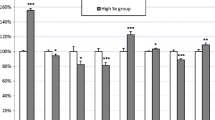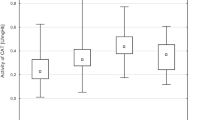Abstract
The study population included employees of metal works, with significant exposure to lead (Pb) for about 20 years (mean blood lead level PbB = 43 μg/dl), divided into four groups: normotensive (Pb-normotensive), high-normotensive, first (HT-1), and second degree (HT-2) of hypertension. The control group comprised of 30 office workers with normal blood pressure and no history of occupational exposure to lead. In erythrocytes, the activity of antioxidant enzymes and lipid peroxidation (measured as concentration of malondialdehyde (MDA)) was estimated. MDA concentration, glutathione peroxide (GPx), and superoxide dimutase (SOD) activities were significantly higher in Pb-normotensive group when compared to the normotensive control. Body mass index, age, duration of exposure to lead, and PbB were higher in both hypertensive groups than in Pb-normotensive or high-normotensive groups. MDA increased in HT-1 group by 48% and in HT-2 by 72%, and the activity of GPx decreased significantly in HT-1 group, by 30% and in HT-2 by 43%. No significant differences were observed in their activity of SOD, catalase, and glutathione reductase in erythrocytes. Arterial blood pressure (both systolic and diastolic) positively correlated with body mass index (BMI), age, lead exposure duration, PbB, MDA, and negatively correlated with GPx. There was no significant correlation between BMI and MDA, BMI and GPx, age and MDA, AND age and GPx. In conclusion: (1) lead increases erythrocyte MDA concentration and the activity of GPx as well as SOD in normotensive subjects. (2) Among individuals exposed to lead, with arterial hypertension diagnosed, higher body mass index, age, values of blood lead level, and prolonged exposure to lead have been noticed, accompanied by intensified oxidative stress and the decrease in the activity of glutathione peroxidase in erythrocytes. The reasons for increase of blood pressure in lead exposure remain unrecognized.




Similar content being viewed by others
References
H. C. Gonick, Y. Ding, S. C. Bondy, Z. Ni and N. D. Vaziri, Lead-induced hypertension: interplay of nitric oxide and reactive oxygen species, Hypertension. 30, 1487–1492 (1997).
S. A. Korrick, D. J. Hunter, A. Rotnitzky, H. Hu and F. E. Speizer, Lead and hypertension in a sample of middle-aged women, Am. J. Public Health. 89, 330–335 (1999).
Z. Ni, S. Hou, C. H. Barton and N. D. Vaziri, Lead exposure raises superoxide and hydrogen peroxide in human endothelial and vascular smooth muscle cells, Kidney Int. 66, 2329–2336, (2004).
N. D. Vaziri and Y. Ding, Effect of lead on nitric oxide synthase expression in coronary endothelial cells: role of superoxide, Hypertension 37, 223–226 (2001).
M. Carmignani, A. R. Volpe, P. Boscolo, N. Qiao, M. Di-Gioacchino, A. Grilli and M. Felaco, Catcholamine and nitric oxide systems as targets of chronic lead exposure in inducing selective functional impairment, Life Sci. 68, 401–415 (2000).
F. Dalloz, V. Maupoil, S. Lecour, F. Briot and L. Rochette, In vitro studies of interactions of NO. donor drugs with superoxide and hydroxyl radicals, Mol. Cell. Biochem. 177, 193–200 (1997).
S. Kasperczyk, E. Birkner, A. Kasperczyk and J. Kasperczyk, Lipids, lipid peroxidation and 7-ketocholesterol in workers exposed to lead, Hum. Exp. Toxicol. 24, 287–295 (2005).
S. Kasperczyk, E. Birkner, A. Kasperczyk and J. Zalejska-Fiolka, The activity of superoxide dismutase and catalase in people protractedly exposed to lead compounds, Ann. Agric. Environ. Med. 11, 291–296 (2004).
S. Kasperczyk, A. Kasperczyk, A. Ostałowska, M. Dziwisz and E. Birkner, Activity of glutathione peroxidase, glutathione reductase and lipid peroxidation in erytrocytes in workers exposed to lead, Biol. Trace Elem. Res. 102, 79–84 (2004).
A. Skoczyńska, Lipid peroxidation as a toxic mode of action for lead and cadmium, Med. Pr. 48, 197–203 (1997).
H. Gurer and N. Ercal, Can antioxidants be beneficial in the treatment of lead poisoning?, Free. Radic. Biol. Med. 29, 927–945. (2000).
W. Wąsowicz, J. Gromadzińska and K. Rydzyński, Blood concentration of essential trace elements and heavy metals in workers exposed to lead and cadmium, Int. J. Occup. Med. Environ. Health. 14, 223–229 (2001).
X. B. Ye, H. Fu, J. L. Zhu, W. M. Ni, Y. W. Lu, X. Y. Kuang, S. L. Yang, and B. X. Shu, A study on oxidative stress in lead-exposed workers, J. Toxicol. Environ. Health A. 57, 161–172 (1999).
T. M. Paravicini and R. M. Touyz, NADPH oxidases, reactive oxygen species, and hypertension: clinical implications and therapeutic possibilities, Diabetes Care. 31Suppl 2, S170–S180 2008, Feb.
Y. Oyanagui, Reevaluation of assay methods and establishment of kit for superoxide dismutase activity, Anal. Biochem. 142, 290–296 (1984).
H. Aebi, Catalase in vitro. Methods Enzymol. 105, 121–126 (1984).
D. E. Paglia and W. N. Valentine, Studies on the quantitative and qualitative characterization of erythrocyte glutathione peroxidase, J. Lab. Clin. Med. 70, 158–169 (1967).
R. Richterich, Chemia kliniczna [Clinical chemistry], Wydawnictwo Lekarskie PZWL [Medical Publishing PZWL], Warszawa [Warsaw] (1971).
H. Ohkawa, N. Ohishi, and K. Yagi, Assay for lipid peroxides in animal tissues by thiobarbituric acid reaction, Anal. Biochem. 95, 351–358 (1979).
I. Ergurhan-Ilhan, B. Cadir, M. Koyuncu-Arslan, C. Arslan, F.M. Gultepe and G. Ozkan, Level of oxidative stress and damage in erythrocytes in apprentices indirectly exposed to lead, Pediatr. Int. 50, 45–50 (2008)
N. Aykin-Burns and N. Ercal, Effects of selenocystine on lead-exposed Chinese hamster ovary (CHO) and PC-12 cells, Toxicol. Appl. Pharmacol. 214, 136–143, (2006)
E. Sugawara, K. Nakamura, T. Miyake, A. Fukumura and Y. Seki, Lipid peroxidation and concentration of glutathione in erythrocytes from workers exposed to lead, Br. J. Ind. Med. 48, 239–342 (1991).
H.M. Korashy and A.O. El-Kadi, The role of redox-sensitive transcription factors NF-kappaB and AP-1 in the modulation of the Cyp1a1 gene by mercury, lead, and copper, Free Radic. Biol. Med. 44, 795–806 (2008)
G. Wójcicka, J. Bełtowski and A. Jamroz, Oxidative stress in hypertension, Postepy Hig. Med. Dosw. 58, 183–193 (2004).
C. Russo, O. Olivieri, D. Girelli, G. Faccini, M. L. Zenari, S. Lombardi and R. Corrocher, Anti-oxidant status and lipid peroxidation in patients with essential hypertension, J. Hypertens. 16, 1267–1271 (1998).
Yang H. Y., P. F. Kao, T. H. Chen, B. Tomlinson, W. C. Ko and P. Chan, Effects of the angiotensin II type 1 receptor antagonist valsartan on the expression of superoxide dismutase in hypertensive patients, J. Clin. Pharmacol. 47, 397–403 (2007).
Y. M. Hsueh, P. Lin, H. W. Chen, H. S. Shiue, C. J. Chung, C. T. Tsai, Y. K. Huang, H. Y. Chiou and C. J. Chen, Genetic polymorphisms of oxidative and antioxidant enzymes and arsenic-related hypertension, J. Toxicol. Environ. Health A. 68, 1471–1484 (2005).
J. Śladowska, A. Wierzbicka, M. Litwin, J. Antoniewicz, A. Niemirska, Z. Wawer, P. Socha, E. Skorupa and G. Grenda, Oxidative stress and hypertensive arteriopathy in children with primary hypertension-preliminary results, Przegl. Lek. 63, 107–110 (2006).
S. Oztezcan, S. Doğru-Abbasoğlu, U. Mutlu-Türkoğlu, S. Cetiner, R. Eker-Omeroğlu, G. Aykaç-Toker and M. Uysal, The investigation of prooxidant-antioxidant balance in serum of children with family histories of essential hypertension, Res. Commun. Mol. Pathol. Pharmacol. 111, 167–174 (2002).
K. Kędziora-Kornatowska, J. Czuczejko, K. Szewczyk-Golec, J. Motyl, L. Szadujkis-Szadurski, T. Kornatowski, H. Pawluk and J. Kędziora, Effects of perindopril and hydrochlorothiazide on selected indices of oxidative stress in the blood of elderly patients with essential hypertension, Clin. Exp. Pharmacol. Physiol. 33, 751–756 (2006).
M. L. Pavão, T. Figueiredo, V. Santos, P. A. Lopes, R. Ferin, M. C. Santos, J. Nève and A. M. Viegas-Crespo, Whole blood glutathione peroxidase and erythrocyte superoxide dismutase activities, serum trace elements (Se, Cu, Zn) and cardiovascular risk factors in subjects from the city of Ponta Delgada, Island of San Miguel, The Azores Archipelago, Portugal, Biomarkers. 11, 460–471 (2006).
J. Pedro-Botet, M. I. Covas, S. Martín and J. Rubiés-Prat, Decreased endogenous antioxidant enzymatic status in essential hypertension, J. Hum. Hypertens. 14, 343–345 (2000).
F. J. Chaves, M. L. Mansego, S. Blesa, V. Gonzalez-Albert, T. Jiménez, M. C. Tormos, O. Espinosa, V. Giner, A. Iradi, G. Saez and J. Redon, Inadequate cytoplasmic antioxidant enzymes response contributes to the oxidative stress in human hypertension, Am. J. Hypertens. 20, 62–69 (2007).
J. Redón, M. R. Oliva, C. Tormos, V. Giner, J. Chaves, A. Iradia and G. T. Sáez, Antioxidant activities and oxidative stress byproducts in human hypertension, Hypertension 41, 1096–1101 (2003).
P. D. Whanger, Selenium in the treatment of heavy metal poisoning and chemical carcinogenesis, J. Trace Elem. Electrolytes Health Dis. 6, 209–221 (1992).
A. I. Othman and M. A. El Missiry, Role of selenium against lead toxicity in male rats, J. Biochem. Mol. Toxicol. 12, 345–349 (1998).
S. Tubek, Role of zinc in regulation of arterial blood pressure and in the etiopathogenesis of arterial hypertension, Biol. Trace Elem. Res. 117, 39–51 (2007).
K. Kędzierska, J. Bober, K. Ciechanowski, E. Gołembiewska, E. Kwiatkowska, I. Noceń, B. Dołęgowska, G. Dutkiewicz and D. Chlubek, Copper modifies the activity of sodium-transporting systems in erythrocyte membrane in patients with essential hypertension, Biol. Trace Elem. Res. 107, 21–32 (2005).
M. Ghayour-Mobarhan, A. Taylor, S. Lanham-New, D. J. Lamb, M. A. Nezhad, S. M. R. Kazemi-Bajestani, F. Ghafouri, C. Livingstone, T. Wang and G. A. A. Ferns, Serum selenium and glutathione peroxidase in patients with obesity and metabolic syndrome, Pakistan J. Nutr. 7, 112–117 (2008)
M. Ozata, M. Mergen, C. Oktenli, A. Aydin, S. Y. Sanisoglu, E. Bolu, M. I. Yilmaz, A. Sayal, A. Isimer, I. C. Ozdemir, Increased oxidative stress and hypozincemia in male obesity, Clin. Biochem. 35, 627–631 (2002)
I. Gjørup, T. Gjørup and B. Andersen, Serum selenium and zinc concentrations in morbid obesity. Comparison of controls and patients with jejunoileal bypass, Scand. J. Gastroenterol. 23, 1250–1252 (1988)
Author information
Authors and Affiliations
Corresponding author
Rights and permissions
About this article
Cite this article
Kasperczyk, S., Kasperczyk, J., Ostałowska, A. et al. The Role of the Antioxidant Enzymes in Erythrocytes in the Development of Arterial Hypertension among Humans Exposed to Lead. Biol Trace Elem Res 130, 95–106 (2009). https://doi.org/10.1007/s12011-009-8323-z
Received:
Accepted:
Published:
Issue Date:
DOI: https://doi.org/10.1007/s12011-009-8323-z




